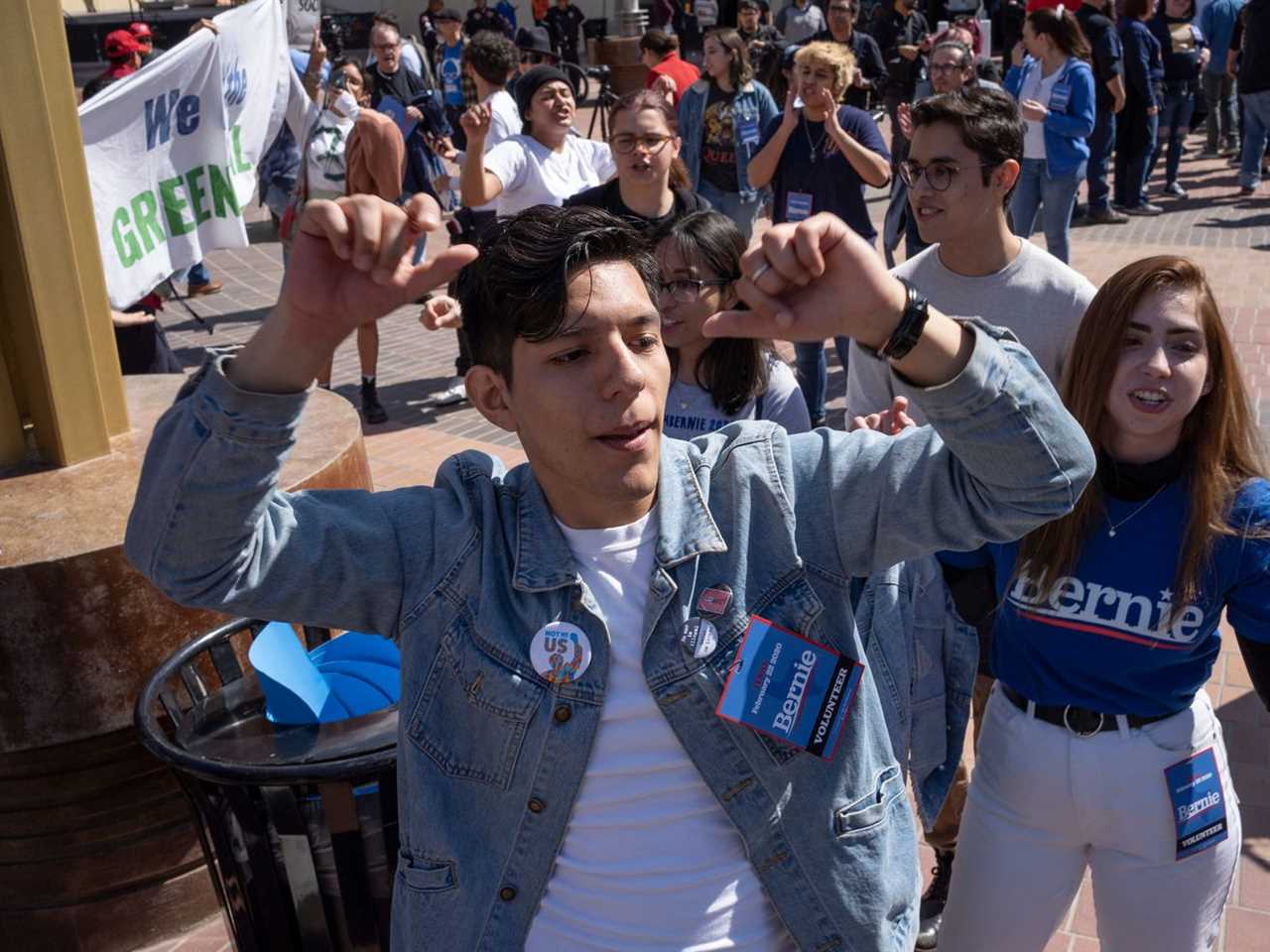
Hispanic voters could swing the 2022 midterms. Here is how that might happen.

Part of The power and potential of Latino voters, from The Highlight, Vox’s home for ambitious stories that explain our world.
Hispanic Americans aren’t just the largest group of eligible minority voters in the US — they’re the fastest-growing voting bloc in the country. And that’s led to a belated, chaotic scramble by Democrats and Republicans to win them over.
Like many minority groups, Hispanic voters have traditionally been assumed to be Democrats. For many years, that assumption was borne out in national voting patterns. But in 2020, the Republican party saw significant growth in its Hispanic support, and recent polls suggest that Democrats’ edge with Hispanic voters has grown even narrower over the past two years.
That has Democrats concerned, Republicans hopeful, and politicians in both parties trying to better connect with and understand the Hispanic community, realizing correctly that their short- and long-term success depends on winning broad swaths of it.
The 2022 midterms are the next test of whether the trends of 2020 will continue. Ahead of that, we’ve put together 10 charts that explain the Hispanic electorate, how it’s changing, and how it could affect this fall’s races.
Hispanic voters make up a significant — and growing — part of the US electorate
While Hispanic generally refers to people with origins in Spanish-speaking countries, this story uses the definition adopted by the Census Bureau in 1997: “a person of Cuban, Mexican, Puerto Rican, South or Central American, or other Spanish culture or origin regardless of race,” as much of the data referenced uses US Census Bureau numbers. That means our usage of Hispanic here may also include people of non-Spanish-speaking origin who self-identify as Hispanic.
Hispanics have accounted for about half of US population growth since 2010. That increase has meant an increase in the voter population. The Census Bureau’s Current Population Survey samples the US population about its voting behavior after the November election every other year. It found that the share of voters who were Hispanic increased from roughly 7 percent in 2008 to more than 10 percent in 2020, while the share of eligible voters who were Hispanic increased from roughly 9 percent to more than 13 percent over the same period.
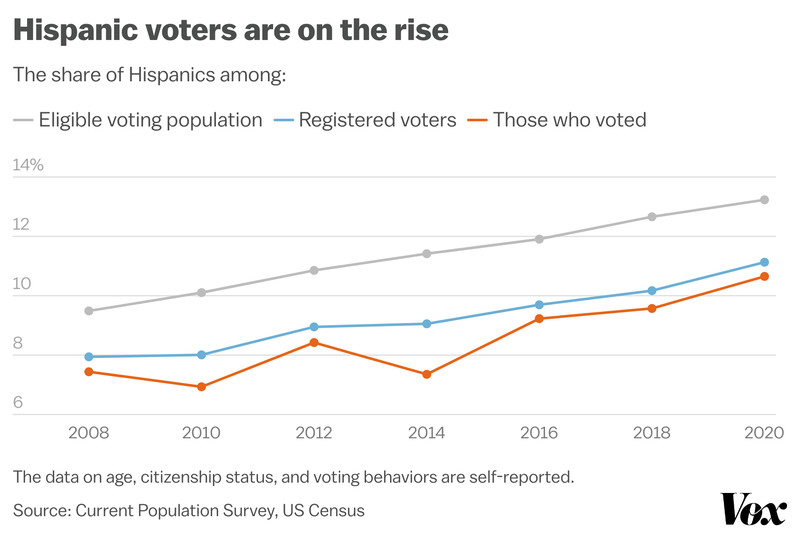
As those numbers suggest, there is a voting gap: In 2020, Hispanics made up an estimated 11.1 percent of those who said they were registered to vote, but only 10.6 percent of those who said they actually voted. Activating those registered voters who chose to stay home (a group of more than 2 million in 2020) represents a large opportunity for both political parties.
And there is an even more significant opportunity in closing the voter registration gap. If all the eligible Hispanic voters actually voted in 2020, there could have been an increase of 14 million votes.
It’s worth noting that a recent paper from researchers at Harvard, Emory, and Tufts found that the self-reported demographic and voting behavior data from the Current Population Survey tends to overestimate the voter turnout rate for minority groups when compared with voter files that documented the actual voting behaviors. That means the voting gap for Hispanic communities in reality is likely even larger than the numbers above suggest.
The voter registration gap is the highest among Hispanic and Asian voters. Because of language and cultural barriers, both groups have historically been ignored by mobilizing campaigns of both parties, according to Rodrigo Domínguez-Villegas, the director of research at Latino Policy and Politics Institute at University of California Los Angeles.
Compared to white and non-Hispanic Black voters, fewer Hispanic and Asian voters were reached by the campaigns in 2020, a Pew Research Center survey found.
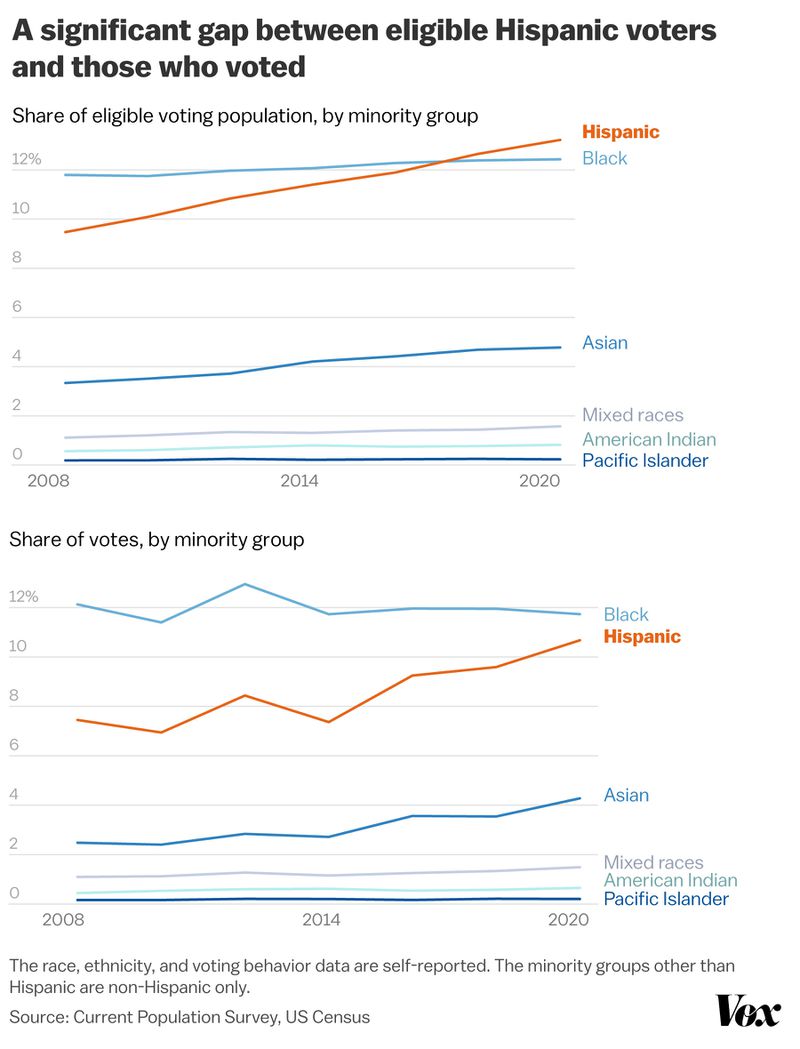
That gap between Hispanic eligibility and participation means there is a relatively large untapped population of potential Hispanic voters — and finding a message that resonates with these potential voters could lead to a significant expansion of a given party’s base.
Campaigns — and get-out-the-vote operations — have had some recent success in activating new Hispanic voters. There’s been an increase in the turnout rate in the last two elections as compared to that of earlier years. Forty percent of eligible Hispanic voters voted in 2018 (compared to 27 percent in 2014), and 54 percent did so in 2020 (47 percent in 2016). It remains to be seen whether Hispanic voters will keep up these gains, though Domínguez-Villegas notes current trends suggest turnout may be difficult to predict this year.
“Voters are less likely to go out to vote if they are generally disappointed at where the country is going,” said Domínguez-Villegas. Many Hispanics are unhappy with the country’s economic conditions, and that could mean fewer voters would turn out.
At the same time, the Supreme Court’s June decision to roll back abortion rights angered many Hispanic voters, especially women and younger people, Domínguez-Villegas said. There’s also an increasing interest from both parties this year in mobilizing Hispanic voters in contested districts and states — more attention paid to Hispanic voters could mean higher turnout. Although it’s unlikely that the share of Hispanic voters will exceed that of Black voters this year, these factors could mean a significant number of Hispanic voters come out to vote in 2022, according to Domínguez-Villegas.
The rise in voter share in recent years has mostly been driven by the enfranchisement of waves of new voters. The share of Hispanic voters among voters who reached their voting age increased over the past seven elections — in 2020, it was up 8 percentage points from 2008, according to the Current Population Survey. The survey does not sample people living in group housing — including many first-time voters living in college dorms. That means the numbers are likely an underestimate for the Hispanic population.
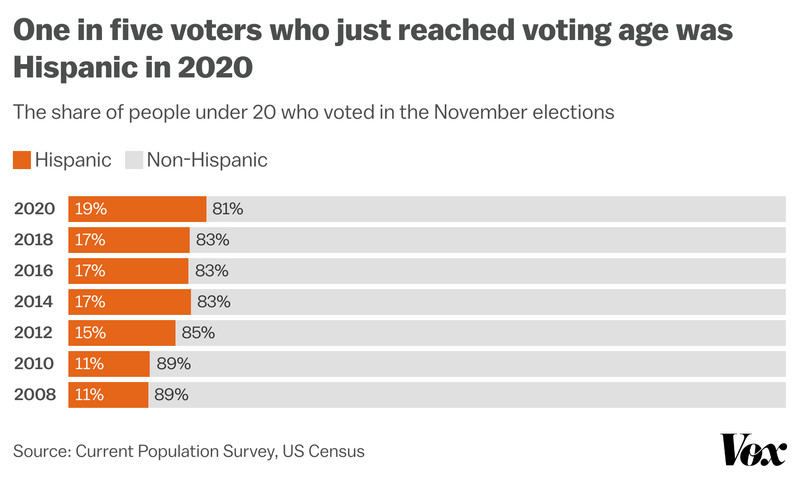
The overall US electorate is becoming more diverse as young people become eligible to vote. The census estimates that non-Hispanic whites will become the minority after 2045. The average age of a Hispanic American citizen was 30 in 2020, compared to 41 for non-Hispanic Americans, according to an analysis of the census data. And that means that while there have been increases in Hispanic vote shares across all age groups, the most significant increase has happened among younger generations.
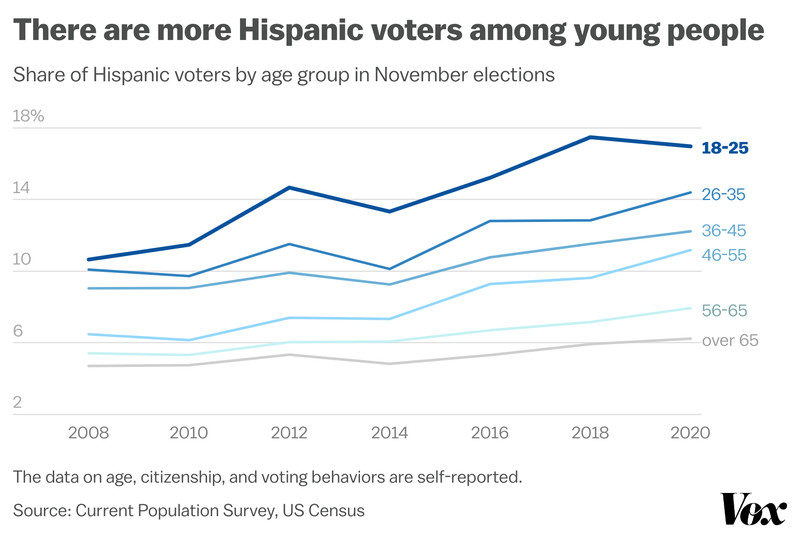
The share of the Hispanic electorate that’s between 18 and 25 will only grow in elections to come: The Pew Research Center projects that at least 1 million US-born Hispanics will turn 18 every year for the next two decades.
However, that doesn’t necessarily mean there will be 2 million new Hispanic voters every election cycle. Just like other young American voters, young Hispanic voters are less politically engaged than their older counterparts, despite being more progressive, according to Mark Hugo Lopez, the director of race and ethnicity research at Pew Research Center. That’s why closing the youth participation gap — something parties have struggled to do for decades — would be particularly advantageous to Democrats.
So what does all this mean for November? Essentially, that there are a lot of untapped potential Hispanic voters for parties to engage with. And that Hispanic voters, as important as they will be in the 2022 midterms, will only become more of a political force in each successive election.
Close to 35 million Hispanics will be eligible to vote in November 2022, according to the Pew Research Center, an increase from 30 million in 2018. Again, not all of those who are eligible will vote, and fewer tend to vote during the midterms. In 2018, about 12 million, or 40 percent, of eligible Hispanic voters actually voted — a particularly high voter turnout rate for the midterms. If the 2022 elections mirror that rate, about 14 million Hispanic people will vote.
That’s a lot of people, and because of how Hispanic Americans are distributed across the US, they’ll be the decisive voices in a number of key races.
Republicans have made gains with Hispanic voters, but Democrats still have the advantage
Most Hispanics have voted for Democrats consistently in both midterms and in the general elections in recent years. As previous surveys showed, Hispanic voters have typically had a more positive view of the Democratic Party, and felt that Democrats have Hispanic communities’ best interests at heart.
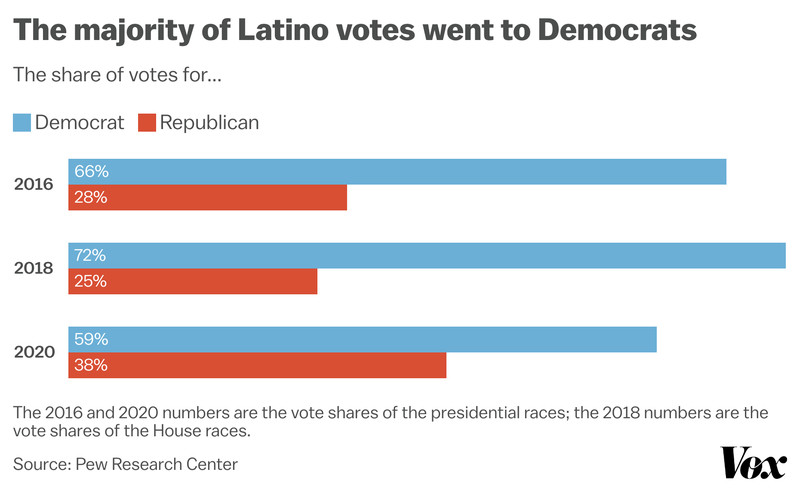
Democrats’ advantage with Hispanics narrowed in 2020. There are a few reasons for that, but as Ray Suarez explained for the Highlight, essentially:
The Latino vote was stronger for Republicans than expected in South Florida, as the party and popular GOP politicians made a strong bid for Cuban American voters, and wooed a growing Venezuelan population by slamming Democrats as socialists unduly sympathetic with governments in Havana and Caracas. And in Nevada’s congressional districts, where the late Sen. Harry Reid made sure the state party had strong outreach to large and growing Latino residents, Democratic candidates won, but not by the overwhelming margins seen in earlier races.
And that means that now, more than ever, a state having a large Hispanic voter base doesn’t necessarily mean it will swing Democratic. While an increase in Hispanic voters has helped turn Arizona blue for the first time since 1996, new Hispanic voters helped power Trump’s wins in Texas and Florida. Though Trump did not win the majority of Hispanic votes in either, he captured enough to win both states.
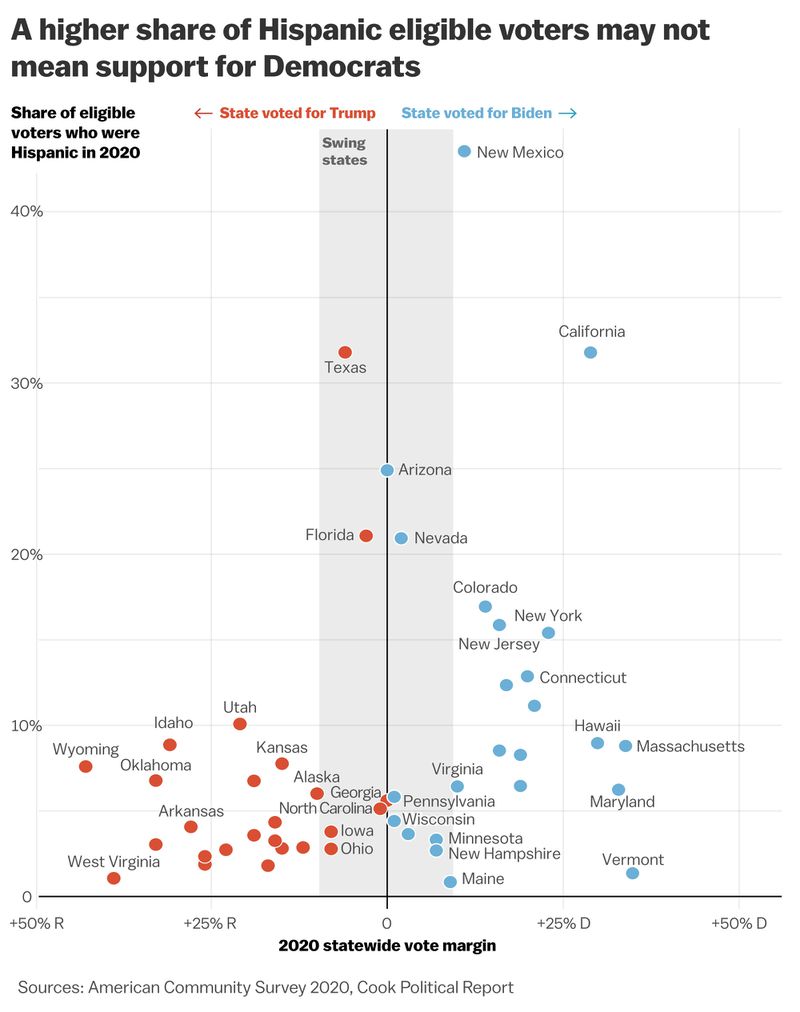
In 2020, seven of the nine states with Hispanics made up at least 15 percent of the eligible voters went to Biden. A higher Hispanic population usually, but not always, meant a Democratic advantage.
Texas saw some of the most radical GOP gains among Hispanic voters. Trump flipped Zapata County, which is more than 94 percent Hispanic, outrunning his 2016 results by about 20 percentage points. And the GOP posted even bigger gains in 96 percent Hispanic Starr County, where Trump got 41.7 percent of total votes, gaining 28 percentage points over 2016 (though Biden still won that county).
An increase in the share of Hispanic voters could swing a state toward Democrats. Texas saw the largest increase in Hispanic votes among all states from 2016 to 2020, and had its election results shift toward Democrats by 3.4 percentage points from 2016. But things can go the other direction, too: California had an equally significant increase in Hispanic votes but saw its margin of Democrats shrink by 0.9 percentage points in 2020 from 2016 levels.
It’s difficult to draw overarching lessons from the state or county data, given the divergent swings seen in places like Texas and California (not to mention due to a preponderance of factors that may have affected how Hispanic voters cast their ballots in each state). As a general rule, however, it does appear that Democrats have not completely lost their traditional advantage with Hispanic voters.
Vox analyzed the increase of Hispanics as a share of eligible voters and the respective voting margin shift in the 2020 presidential elections for 429 counties (excluding DC) where the data is available. (They cover 79 percent of the country’s Hispanic voting population. Because smaller counties were made unidentifiable to preserve privacy by the census, the data likely overrepresents Hispanics in urban areas and underrepresents those in rural areas). We found that 85 percent of the counties that saw an increase in Hispanic eligible voters of more than 2 percentage points shifted to Democrats; the other 15 percent shifted Republican. Most counties shifted Democrats regardless of their changes in the Hispanic vote share in 2020.
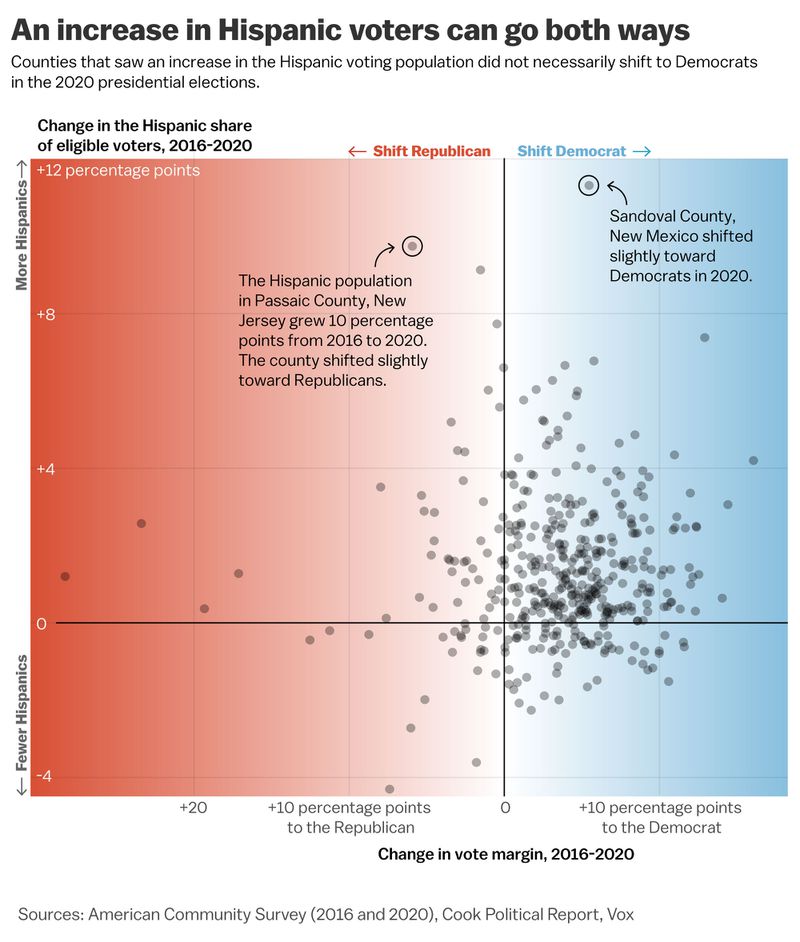
The data shows that, on the county level, there hasn’t been a uniform pattern of Hispanic voters shifting toward Republicans yet, but that Democrats are right to be concerned about losing these voters, particularly in conservative areas where Hispanic population make up the majority.
Hispanic voters have the power to sway elections in 2022
A number of key races this year are in areas with a sizable share of Hispanic voters. Both parties are vying for Senate and gubernatorial seats for Arizona and Nevada, where one in four eligible voters are Hispanic. In Georgia, where the Hispanic share of eligible voters is about 6 percent, Democratic Sen. Raphael Warnock is up for reelection and is likely to have a close race.
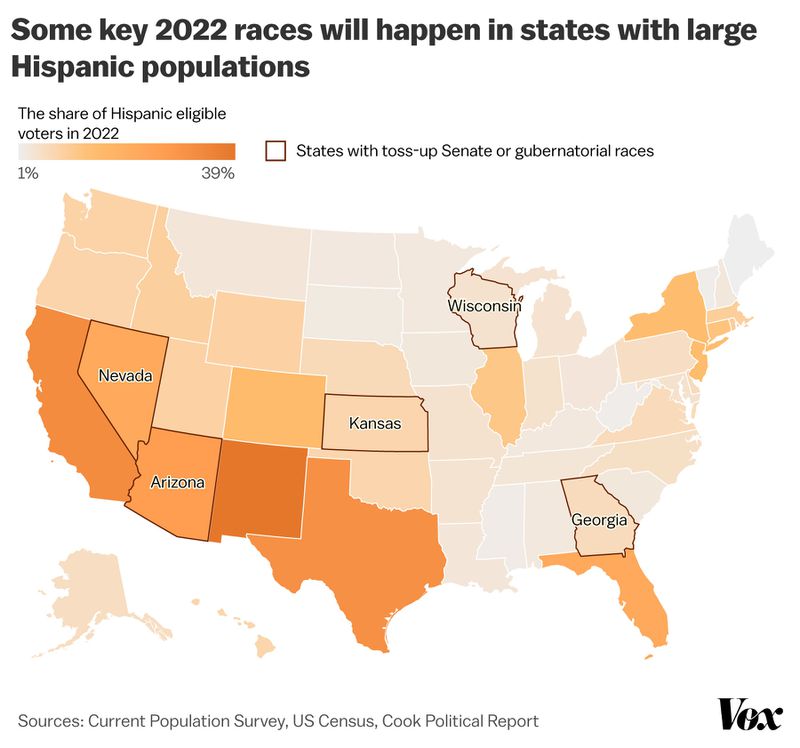
Democrats are hoping to keep their narrow control of the Senate. They’re on defense in Georgia, Arizona, and Nevada and trying to pick up a seat in Wisconsin. Polling suggests tight races in these four states. Keeping their one-seat majority will require Democrats to win Hispanic votes.
In the Arizona Senate race for example, Democratic incumbent Sen. Mark Kelly won his 2020 special election by about 2.4 percentage points. Exit polls suggest Kelly won upward of 60 percent of the Latino vote, and that he lost with white voters to his GOP rival, Martha McSally, by 6 percentage points. While there’s certainly a path to victory for Kelly that involves somehow winning over a large segment of the white voters who back McSally, he’s more likely to keep his seat by maintaining — or building on — the Latino support he enjoyed in 2020. As Hispanics make up roughly a quarter of the state’s eligible voters, that community could swing things in 2022.
Some close House races will also take place in areas with large Hispanic populations or population growth.
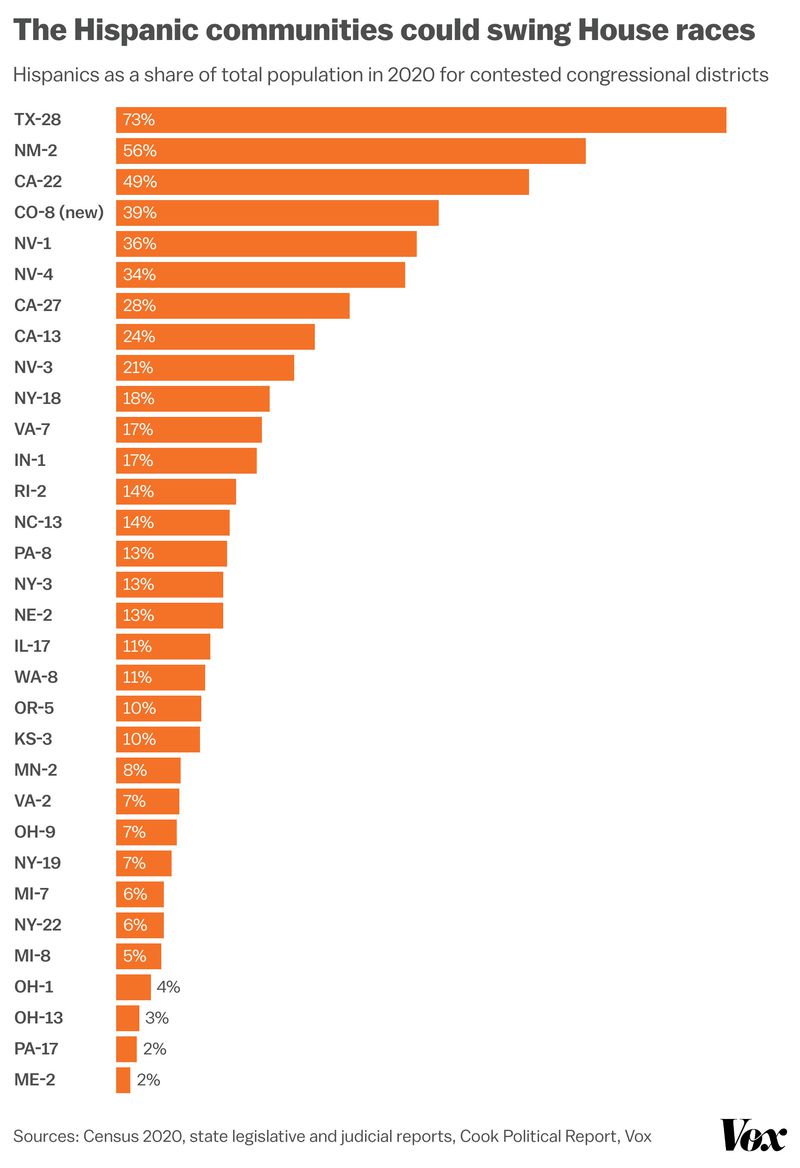
A small percentage of Hispanic voters in toss-up races could ultimately decide the control of the House — or, more likely, the size of the House’s Republican majority.
In Texas’s 28th Congressional District, for example, Democratic incumbent Rep. Henry Cuellar faces another Hispanic candidate, Republican Cassy Garcia. Hispanics make up 73 percent of the eligible voters.
Hispanic voters could also be pivotal in districts in which Hispanics aren’t the majority, like Colorado’s Eighth Congressional District, a new seat. It is the most diverse district in the state: 38.5 percent of the population there is Hispanic. Biden won in 2020 with a narrow 1.3 percent margin.
While Hispanic voters hold sizable voting power, they’re far from a homogenous group. Vast generational, regional, and socioeconomic differences mean Hispanic communities care about a wide range of issues. Their concerns are largely in line with what other communities say are top issues facing the country.
Before the 2020 elections, Hispanic voters rated the economy, health care, and Covid-19 as their top concerns. This July, gun violence, inflation, and climate change were among the most important issues to them.
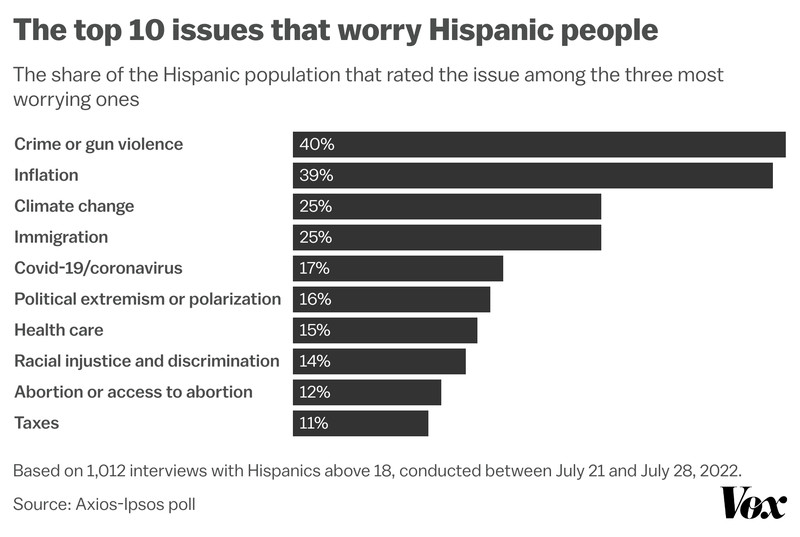
“Just as every time we have done the survey, the top issues facing the country as identified by the general US public are also the same issues we see Hispanics pointing to as important to them,” said Lopez from Pew Research Center.
It’s still too early to definitely say how each party will fare with Hispanic voters this year, though Democrats have a historical advantage. Overall, though, the path to recruiting more Hispanic voters is clear: Those who can activate new Hispanic voters and speak to the issues they care about are more likely to hold the advantage entering November.
----------------------------------------
By: Youyou Zhou
Title: The power of Hispanic voters, in 10 charts
Sourced From: www.vox.com/the-highlight/23331025/hispanic-voter-power-10-charts-midterms-2022
Published Date: Tue, 20 Sep 2022 10:41:23 +0000






